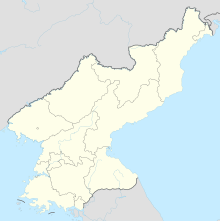Nuclear weapons test in North Korea on September 9, 2016
On 9. September 2016 at 12:30:01 UTC one has nuclear weapons test in North Korea observed. It was the second test of its kind in 2016, the first on January 6th.
procedure
An explosion registered by the USGS earthquake observatory was classified as a nuclear weapon test with an explosive force of around 10 kt TNT equivalent , according to reports from the South Korean news agency Yonhap . More precise evaluations were carried out later, in which the seismological data from the German IMS measuring station GERES and the Graefenberg array were also used, which had also registered the vibration at a distance of 8,200 km with a delay of almost 12 minutes. They estimated the actual strength of the charge at 25 kt (± 7.5), which is roughly 150 to 250% of the explosive power of the atomic bomb on Hiroshima .
The vibration reached magnitude 5.3 on the sky wave magnitude scale at a height of 0 m (underground), about 19 km northeast of Sungjibaegam. Nuclear tests were carried out there in 2006, 2009, February 2013 and January 2016.
A few hours later, the government of North Korea confirmed the successful implementation of its most powerful nuclear weapons test to date on state television KCNA and declared that it was "now able to mount nuclear warheads on launchers ". It also stated that no radioactivity whatsoever was released into the earth's atmosphere during the test .
Preparations and history
![]() Map with all coordinates: OSM | WikiMap
Map with all coordinates: OSM | WikiMap
Ignition was executed just as in the previous events of the North Korean nuclear weapons program in a deep in the bedrock of the mountain range sunk shaft . ⊙ International observers had already observed and suspected the preparations based on the analysis of satellite images . The seismological evaluations of various earthquake control centers located the blasting site at about the height of the sea level, which means that the shaft must have been sunk about 1,300 m deep, i.e. much deeper than what happened in the previous experiments with 310, 490 and 1,000 m below the surface of the earth .
Regularly been used for the construction of pilot plants political prisoners from past political purges of North Korea, in which only about 30 km east located hwasong concentration camp ⊙ were staying.
The prisoners, who were imprisoned for life, were always led to believe that they were working in the mining industry or on a “ subway construction site”. A former overseer who fled reports that none of the workers deployed there never returned to the camp, so there are no eyewitness reports.
Reactions
The spokesman for the US National Security Council rated the process as questionable and the fifth nuclear test carried out by North Korea to date. Even Russia and China condemned or criticized the nuclear test.
Japan considered appealing to the UN Security Council and provided two Kawasaki T-4 training aircraft that had been specially converted to take air samples.
NATO Secretary General Jens Stoltenberg called on North Korea to immediately stop all nuclear activities and tests with ballistic missiles . In South Korea , the National Security Council was convened for an emergency meeting. The State Environmental Protection Agency in China instructed the three measuring stations near the border to monitor any ionizing radiation that may be emitted . The CTBTO announced the activation of a total of 25 measuring stations to assess the effects.
Germany, which is one of the few Western countries that has diplomatic relations with North Korea at all , immediately summoned the ambassador and resolutely condemned the provocation.
UN - Secretary-General Ban Ki-moon condemned the test as "brazen breach of UN resolutions" and called later in the day the UN Security Council , chaired by New Zealand one. The 15 member states unanimously decided to impose additional economic and trade sanctions on North Korea.
The North Korean dictator Kim Jong-un then had a spokesman for the Ministry of Foreign Affairs proclaim that the announced sanctions were "laughable". North Korea will continue to work on its nuclear weapons program and announced that it will carry out another test shortly. Furthermore, he now demands recognition as a nuclear weapon state .
Expert reports
A spokesman for the South Korean Ministry of Defense announced that another nuclear test in North Korea is planned for the near future. South Korean and international observers believed a third tunnel had already been completed. Its ignition took place on the orders of the ruler Kim Jong-un about a year later during the nuclear weapons test in North Korea on September 3, 2017 .
The US nuclear weapons specialist Siegfried Hecker estimated that North Korea had enough plutonium in November 2016 to build around 20 warheads and increase this capacity by 7 more each year. North Korea's launch vehicles could probably be powerful enough in five to ten years to reach the American mainland.
See also
- Punggye-ri (proving ground)
- Hwasŏng Detention Center
- Nyŏngbyŏn nuclear facility
- further North Korean nuclear weapons tests in 2016
Individual evidence
- ↑ USGS earthquake report
- ↑ a b Press report M5.3 North Korea (Eng.)
- ↑ Zeit-online press report from September 9, 2016
- ↑ a b report of the BGR
- ↑ Nuclear test 2013
- ↑ a b press report Tagesschau from September 9, 2016
- ^ Hwasong Concentration Camp
- ^ New York Times
- ↑ Japantoday press release of September 9, 2016
- ^ After nuclear test: International criticism of North Korea. tagesschau.de. Accessed September 9, 2016.
- ↑ Press report Spiegel online from September 9, 2016
- ↑ Press report Zeit online from September 10, 2016
- ↑ ridiculous sanctions
- ↑ Spiegel press report from September 15, 2016
- ↑ a b c Reuters press report from September 13, 2016 (English)

